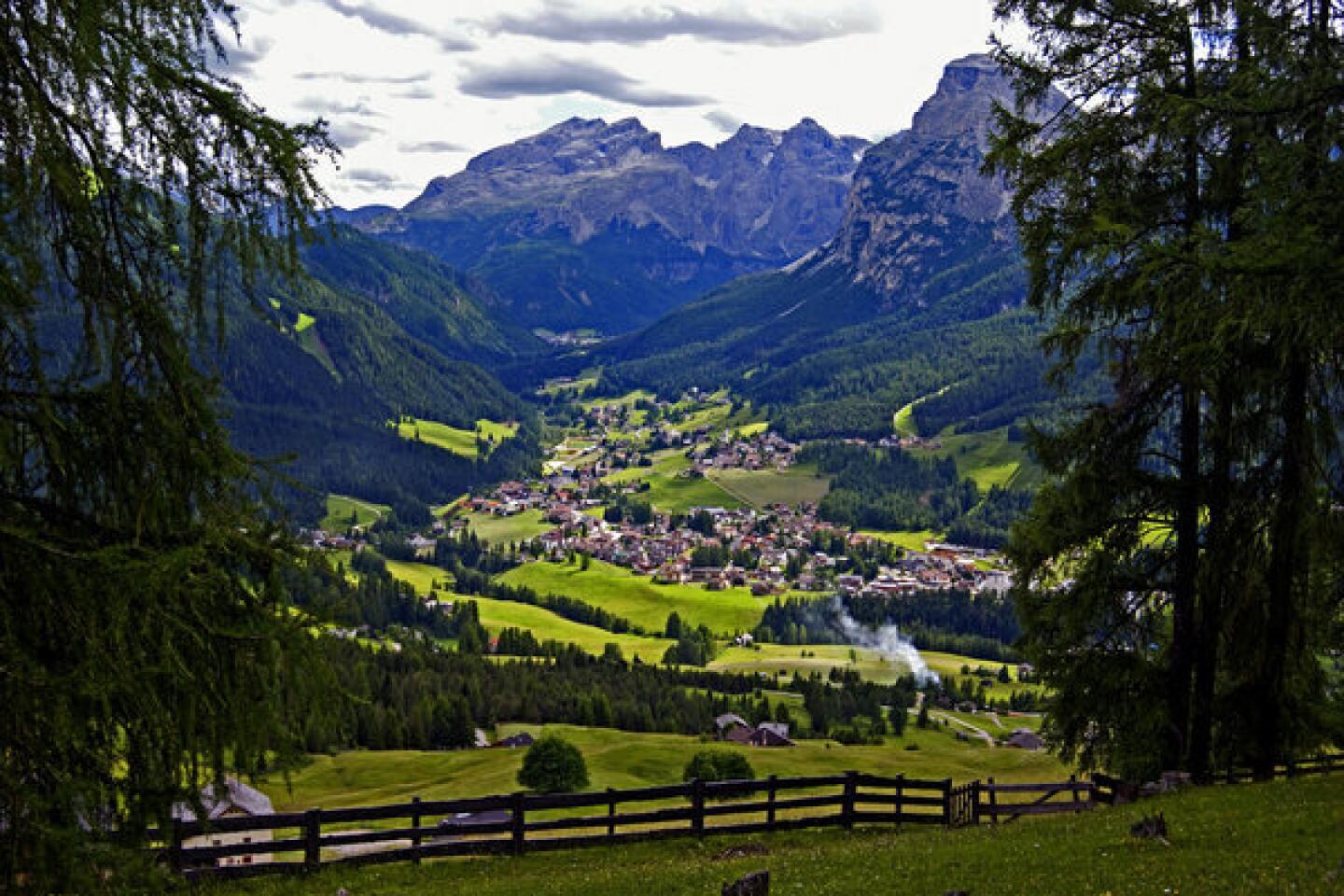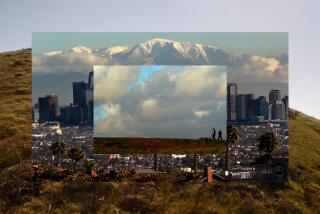Hiking Italy’s Dolomites is challenging and beautiful
- Share via
CORTINA D’ AMPEZZO, Italy — Hiking up a road should be simple, right?
It’s relatively wide, so you’re not apt to step off and tumble down the mountain.
It’s relatively smooth, so you’re not likely to stumble.
So why am I stopping for a breather every couple of hundred yards while I just saw a guy pushing a baby buggy down the road and my “baby” is by this time somewhere near the top?
Well, there is that little matter of grade — or steepness — and Italy’s Dolomites, though not of the dizzying height as the Rockies, do make the grade.
Karin Pizzinini, our guide, estimates the grade on this road at 20%. To put that in perspective, those steep grade warnings you see while driving typically are on roads with a 5% to 7% grade. Vail Pass in Colorado is a 7%.
So this single-lane road leading us to our lodging for the night at Rifugio Fodara Vedla is almost three times as steep as Vail Pass. That makes me feel a little better, as does seeing a woman mountain biker descend behind the baby-buggy man by straddling the seat of her bike and tiptoeing down the steep incline.
Still, Karin and I get to the top 40 minutes behind my “baby.” That would be my older son, Kirk, who is winding down a summer sabbatical from his law firm in Kansas City, Mo., and had asked whether I wanted to do a trip together. The result was this five-day hut-to-hut hike through the Dolomites, one of the most spectacular mountain ranges in the world.
It’s been named a UNESCO World Heritage Site for what the organization describes as “some of the most beautiful mountain landscapes anywhere.”
Hiking here is no walk in the park. Sure, there are times during our trek in August when we stroll through green valleys and drink in the view of the stark white and gray towers, spires and pinnacles surrounding us. But the vast network of trails also takes us through and up and over that landscape, then steeply back down. “These are the Dolomites,” Karin says. “Up and down.”
Karin makes TV documentaries and teaches but also hires out as a guide for companies such as Dolomite Mountains, which arranged our trip. The company, which is in San Cassiano, about 115 miles north of Venice, offers organized hiking and biking trips in the summer and skiing outings in the winter. It also can put together custom trips such as our hut-to-hut jaunt, staying in lodgings in remote locations that generally are accessible only to bikers and other hikers.
Hut — or rifugio in Italian — might be a misnomer for these structures, which are sprinkled about the region. Though the level of amenities is diverse, the ones we stayed in were sizable enough to lodge dozens of people, some in dormitories and some in private rooms, feed them and provide sometimes public and sometimes private toilet and shower facilities.
The rifugi also are popular for lunch stops, as we find on our first day, doing a day hike out of La Villa, near San Cassiano. Rifugio Puez, which sits at about 8,100 feet — 5 miles and 2,700 feet above our starting point — is chockablock with other hikers, probably at least a hundred, and more than Karin says she has ever seen there. That said, during our five days on the trail we often could go hours without seeing anyone else.
The hike up to the rifugio and back down to La Villa gives us a chance to test our legs, and I quickly find that, though I’m an avid biker who typically rides at least 1,500 miles a year in very flat Chicago, the altitude and steepness of the terrain are going to be a challenge.
The hike also pointed out the value of having a guide, despite the profusion of trail maps in stores. Twice Karin has to help groups of hikers with maps who still are headed the wrong direction. These mountains are not the place in which to get turned around.
They also aren’t what you might choose as a place to fight a war. Yet this rugged terrain is littered with remnants from the Italian and Austro-Hungarian forces that clashed here during World War I and was chronicled in Hemingway’s “A Farewell to Arms.”
We see those remnants close up as we start the third day of our hike from Rifugio Lagazuoi, which sits at a little more than 9,000 feet and enjoys a stunning panoramic view that includes Marmolada (10,964 feet) and Antelao (10,709 feet), the highest peaks in what are also called the “pale mountains.”
We pick our way through a rock field littered with scree on a sometimes ill-defined trail that is occasionally signed by number markers painted on large boulders. Early on there are tunnels into the rock and hollowed-out holes that had served as machine-gun nests.
“Watch out for the wire,” Karin says, and we step across a single strand of rusted barbed wire.
Farther on we come on trenches, then bits of buildings — wood chunks, bricks perhaps used for ovens — and rusted tin cans and shards of glass. It’s amazing to see these leftovers of a war fought nearly 100 years before and to ponder what a soldier’s life must have been like trying to survive not just the enemy but also the elements.
We pause by a tiny lake — one of the few bodies of water we see during our time here — before starting a challenging hike up a chute.
Kirk, who’s 44 and 22 years my junior, surges ahead on the 1- to-2-foot-wide trail that switchbacks toward the top, while Karin, ever the good guide, stays behind with me as I stop often to catch my breath and occasionally sneak a dizzying look back down the chute.
At the top we take a break for water and snacks and enjoy the view of the steep, rock-littered path down that awaits us and the flatter valley beyond. Other hikers, coming from the direction of our destination rifugio, crest the trail, then head down the chute we had just climbed.
Some of these hikers are doing routes similar to ours. Others are tackling some of the alta vie, or high paths. These long-distance trails generally require at least a week to hike.
At Rifugio Lagazuoi we had shared a table at dinner with Roman and Sibylle from Freiburg, Germany, who were hiking the 90-mile-long Alta Via 1, one of the most popular alta vie. They had just hiked down the chute that we would encounter the next day.
Roman tells us they had decided to do Alta Via 1 after seeing a TV documentary and were glad they’d come. Though Germany has its own mountains, “We’ve never seen mountains this high,” he says. “They’re very impressive.”
Besides their link to World War I, the Dolomites also are home to the Ladin culture, which Karin tells us developed after the Romans invaded the region two millenniums ago and is the most ancient culture of the Alps.
Ladin is among the six languages she speaks, and the documentaries she helps produce document the work of Ladin artists.
Ladin dishes, along with Italian and German influences, also show up on menus at the rifugi and other restaurants in the region. That translates into a mix of pasta, schnitzels, stews and other hearty fare.
Meals and time in our room at night are a good opportunity for Kirk and me to connect on a deeper level than what we typically experience when talking on the phone or the occasional times we can get together in the U.S. We talk about the frustrations and successes of life and work, and mutual experiences as a father. I tell him that as I grow older, I sometimes encounter things in life that make me regret not having known my own dad better.
These are not breakthrough moments, just good, satisfying sharing between two trail mates who happen to be father and son too.
Like hiking, the trek through life isn’t without its challenges. But the payoff comes with the experiences and the memories.
Thanks for the memories, Kirk.
Thanks for the memories, Dolomites.
More to Read
Sign up for The Wild
We’ll help you find the best places to hike, bike and run, as well as the perfect silent spots for meditation and yoga.
You may occasionally receive promotional content from the Los Angeles Times.







